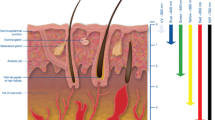Abstract
A significant advantage of Er:YAG and Ho:YAG laser radiation is that it can be transmitted efficiently by fibre, unlike that of the CO2 laser. The important characteristic of excisions made by these mid-infrared-beam lasers is the depth of coagulation beneath the excised surface. Intuitive physical arguments are developed to predict the coagulation depths, which are estimated to be 12μmand 650 μm for Er:YAG and Ho:YAG lesions respectively. These values are in agreement with derivations using more sophisticated physics by the same author elsewhere.
Similar content being viewed by others
References
Hall RR, Beach AD, Baker E and Morison PCA. Nature 232: 131–132
McKenzie AL. Phys. Med. Biol. 31: 967–983
McKenzie AL. Phys. Med. Biol. 28: 905–912
Bayley JG, Kartha VB and Stevens WH. Infrared Phys. 3: 211–233
McKenzie AL. Phys. Med. Biol. 34: in press
Author information
Authors and Affiliations
Rights and permissions
About this article
Cite this article
McKenzie, A.L. Theoretical limits to soft-tissue damage by Er:YAG and Ho:YAG lasers. Laser Med Sci 4 (Suppl 1), 25–30 (1989). https://doi.org/10.1007/BF02276667
Issue Date:
DOI: https://doi.org/10.1007/BF02276667




